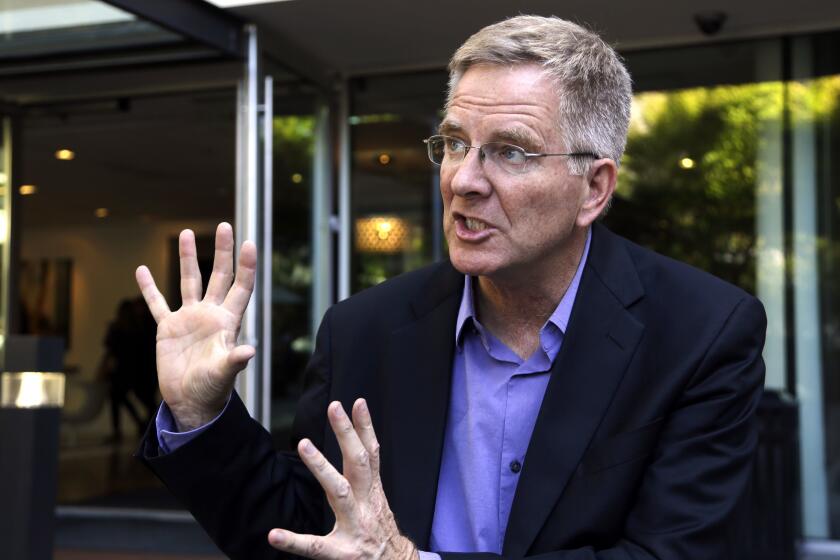A Search for Opals in the Australian Underground
We went underground here in the outback. It’s the normal thing to do. Half the people in Coober Pedy, isolated hundreds of miles from other villages, live underground.
Most visitors to this continent fly to such better-known attractions as Ayers Rock, the world’s largest monolith, and Alice Springs in Australia’s center, but a few travel overland, stopping here to discover an underground world unknown even to many Australians.
About 2,000 Coober Pedy residents live in underground homes they’ve burrowed into the sides of hills to escape the tremendous desert summer heat, winter cold, dust and insects.
Shops, offices, a book shop, pottery maker, jewelry stores, two of the town’s three churches, even motels and a camping area are below ground.
As in the deeper opal mines, which are the reason for Coober Pedy’s existence, walls and ceilings of the homes and apartments require no support. Beneath the surface sand and dirt, the soil is hard gypsum silica sandstone. Some residents varnish their subterranean rock walls but most do not bother, as the natural sandstone is sturdy and handsome.
But folks here have reached an impasse: Although the town has been extended three times, they’ve run out of hills. So part of Coober is now above ground, including its school for nearly 400 pupils, a technical college, two service stations, a 20-bed hospital, general store, two markets, a miners’ store, restaurants and some motels.
With its dirt roads and ramshackle buildings, Coober Pedy, which is aborigine for “white man in a hole” (a reference to the cave houses and mines that dot the landscape), looks like a town from California’s Gold Rush days. Except instead of gold, opals are the magnet.
Individual Prospectors
Eighty percent of the world’s opals come from this settlement in South Australia’s desert. The little fellow can still make it big here, for the government has maintained laws regulating the size of a single mining claim. This keeps out the big corporations and draws individual prospectors.
Partnerships continue to be formed by a handshake, providing a claim twice as large for two miners to seek their fortunes. Some old-timers still use divining rods and discover opals at the top of a slide or fault.
Unlike California’s 49ers, many miners bring their wives and families. The “saloons” here consist of pubs in the town’s motels. And instead of bawdy houses there’s a snack bar, Greek pizza house and three restaurants, plus clubs formed by the Italian, Greek and Yugoslav immigrants who make up most of the populace.
Midway to Alice Springs we arrived at the Coober depot aboard a Greyhound bus at an unholy 2:25 a.m. The driver handed us keys and directed the half-dozen of us on the so-called “Greyhound Tour” across the road to the Opal Inn Motel.
We’d traveled 600 miles north from Adelaide for 12 hours over Stuart Highway, the mostly asphalt, two-lane strip that bisects Australia from north to south. In “downtown” Coober the roads turn to dirt, winding off the paved central three blocks lined by the haphazard sites of above-ground and underground buildings.
The world’s opal capital is no Club Med. Set among low hills, without trees or other greenery, shacks and block houses share the barren landscape with underground houses and power poles that wander off into gullies.
Like Giant Ant Hills
From the mulga scrub on the edges of town, the opal fields spread 30 miles in all directions, marked by tunneling machines and mine tailings that look like giant ant hills.
Coober Pedy is one of the earth’s most unusual places, intriguing to travelers curious about a life style unlike that of any other place on the planet. The moon-like terrain attracted the producers of “Mad Max Beyond Thunderdome” in their search for the movie’s near-end-of-the-world setting.
The town does have a golf course, but no grass--it’s all sand. Also a race track, with a football field in the middle of it, and a drive-in theater that’s been closed since 1984. A TV channel is picked up via satellite.
Most important, Coober has plenty of water, thanks to a year-old desalination plant that makes the salty moistures below the parched surface drinkable.
The apparent chimneys protruding from the hills are air shafts for the underground dwellings. The dugouts, as these homes are called by the locals, maintain warmth during the cold winter nights and hold the temperatures between 70 and 80 degrees in the summer when outside it may soar to 135. “The summer of ‘84,” guide Tom Campagna told us, “we had 21 straight days between 110 and 120.”
Campagna, who with his family has lived in Coober for 17 years, operates three tour buses, two taxis, a rent-a-car business, an aviation fuel distributorship and an opal mine, and acts as weatherman and owns two underground rental apartments. He cuts, polishes and sells opals in one apartment, part of which is rented to a Chinese family.
The Opal Market
“Chinese control the opal market, 20 to 25 of them,” Campagna said. “They come here, rent a motel room, leave their doors open even at night for miners selling opals, then fly back to Hong Kong to finish and mount the rough stones. Their buyers are mostly Americans.”
Coober Pedy was born in 1915 when a 14-year-old waiting for his father and other gold prospectors to return to camp noticed reflections in some stones he was kicking in the dirt. He showed the luminous rocks to his dad. News of the discovery became public and, with the end of World War I, returning soldiers converged on the area.
Facing the summer/winter climatic extremes, the veterans drew on their trench-digging experience in Europe by burrowing bunkers into the rock to create comfortable shelters.
Since then a favorite pastime of visitors and some miners’ wives has been “noodling,” scratching around dump hills for opals. Our noodling turned up only some potch, non-commercial, low-grade opal stones, but five or six years ago a tourist picked up what he thought was potch and took it back to his motel.
Ready to throw the rocks away, he placed them on the breakfast table. The eyes of his opal-wise waitress nearly fell out. The visitor sold his find for more than $100,000. Others have noodled out stones worth five figures, according to Campagna.
Besides striking it rich in opals, the second major attraction is the area’s underground life. The buried homes are far from cave dwellings. Most have showers, flush toilets, electricity and are furnished with refrigerators, microwave ovens, carpeting and TV sets. Several have swimming pools.
A side advantage of living underground, according to one miner with a wife, two kids and a dog is that “your home’s easy to build. You find a hill, dig into it, make how many rooms you like. Then as your family expands, you just dig another room.” Fireplaces, shelves and cupboards are readily added.
At times the relatively low building expenses are further offset by finding opals while tunneling houses. One man picked up nearly $1,000 worth while digging a bathroom.
Two-Story Homes
Some homes are two stories--one underground, one above the ground. The 19 rooms of the Desert Cave Motel are on four levels, two underground, two above, complete with shopping and restaurants. Another new sub-surface motel is being built and one expanded.
The dugouts withstand the heaviest rains, floors staying dry and ceilings watertight.
Little wear shows in the spacious home of John and Lorraine Haines, which is from 30 to 50 years old, depending on which section you’re in. Its large family room and indoor pool are above ground, the rest underground. During the Australian spring and summer (November-April), Lorraine, who came here 10 years ago on a holiday, opens windows set in front of their luxurious “cave.”
Less elaborate are the dugouts of a few miners who have tunneled into hills to live with their aborigine wives. About 250 other aborigines live in the Umoona Community, a reserve established by the government on the edge of town in 1930.
Crocodile Harry’s dugout has become an art gallery for the paintings and ferroconcrete sculptures that Harry, a former croc hunter in the Darwin area, and his wife Marta have created. A one-time Latvian named Arvid von Blumental, Harry began his gallery with a carving of a crocodile. He charges admission (65 cents) to the gallery, meanwhile mining for opals beside his cave dwelling.
Malcolm Hall, the husky, beetle-browed Greyhound manager who has a built-in alarm clock enabling him to meet coaches at all hours of the night and early morning, can fill you in on other Coober Pedy personalities such as “Aeroplane George” and Carl Willie.
If you push him, he’ll even tell you the story of “The Long Drop” gaseous explosion that almost blew Coober off the map a few years back before the town had lots of plumbing and miners were still using their 90-foot shaft holes for privies. A few “long drops” are still in use.
One Aussie described Coober Pedy to us as “a place where people want to fall out and disappear from society, people saturated with social demands.” Among the fallouts have been a famed pianist and some ex-convicts who wished to start new lives.
The nearest town is Woomera, more than 250 miles south. Alice is nearly 500 miles north. There’s nothing east or west.
Asked about Coober Pedy by a National Geographic writer 10 years ago, an Adelaide man replied, “It’s hell on earth, and any man who takes his wife there has no respect for her.” Coober hasn’t changed much.
A night at the Opal Inn runs $45 with breakfast, an underground motel about the same. For further information contact the Australian Tourist Commission, 3550 Wilshire Blvd., Suite 1740, Los Angeles 90010, phone (213) 380-6060.
Sign up for The Wild
We’ll help you find the best places to hike, bike and run, as well as the perfect silent spots for meditation and yoga.
You may occasionally receive promotional content from the Los Angeles Times.



